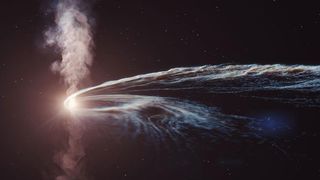Astronomers have spotted a black hole mysteriously spewing up chunks of a devoured star several years after consuming it.
The event, which scientists have classified as AT2018hyz, began in 2018 when astronomers saw the black hole ensnare a hapless star in its strong gravitational pull before shredding it to pieces. Then, three years later, in 2021, a New Mexico radio telescope picked up a signal indicating unusual activity — the black hole had begun burping the star out at half the speed of light.

An artist’s illustration of a black hole shredding a star. (Image credit: DESY, Science Communication Lab)
Black holes have previously been spotted gobbling down stars before vomiting them out, but until now, the ejection has only ever taken place at the same time as the meal. The researchers used four Earth-based observatories located around the globe and two observatories in space to spot the event; they published their findings Oct. 11 in The Astrophysical Journal.
“This caught us completely by surprise — no one has ever seen anything like this before,” lead author Yvette Cendes (opens in new tab), an astrophysicist at the Harvard and Smithsonian Center for Astrophysics, said in a statement.
Black holes are messy eaters that like to play with their food. A black hole’s consumption of a star is called a tidal disruption event (TDE) because of the powerful tidal forces that act upon the star from the black hole’s gravity. As the star is reeled ever closer to the black hole’s maw, the black hole’s tidal forces strip and stretch the star layer by layer; transforming it into a long, noodle-like string that gets tightly wound around the black hole like spaghetti around a fork to form a ball of hot plasma. This is known as spaghettification. This plasma quickly accelerates around the black hole and spins out into an enormous jet of energy and matter, which produces a distinctive bright flash that optical, X-ray and radio-wave telescopes can detect.
But AT2018hyz is unusual: Not only did it wait for three years after snacking on the star to emit a flash, but the speed of the material sent flying from its mouth is staggering. Most TDE outflows travel at 10% the speed of light, but the ejected star matter of AT2018hyz is traveling as fast as 50% the speed of light.
NASA has simulated several tidal disruption events that occur when star venture too close to a black hole. The simulated stars are “one tenth to 10 times the Sun’s mass,” according to NASA’s Goddard Space Flight Center. Credit: NASA’s Goddard Space Flight Center
“We have been studying TDEs with radio telescopes for more than a decade, and we sometimes find they shine in radio waves as they spew out material while the star is first being consumed by the black hole,” study coauthor Edo Berger (opens in new tab), a professor of astronomy at Harvard University, said in the statement. “But in AT2018hyz there was radio silence for the first three years, and now it’s dramatically lit up to become one of the most radio luminous TDEs ever observed.”
Cendes believes it could be belatedly expelling its earlier meal. “It’s as if this black hole has started abruptly burping out a bunch of material from the star it ate years ago,” Cendes added.
The researchers aren’t sure what is causing the flash to be delayed, but they think this postponed could be more common than once thought. To test if that’s the case, astronomers will need to look at sources of other TDEs, previously assumed to be out of action, to see if they can catch them flashing once more.
“This is the first time that we have witnessed such a long delay between the feeding and the outflow,” Berger said. “The next step is to explore whether this actually happens more regularly and we have simply not been looking at TDEs late enough in their evolution.”
Ben Turner is a U.K. based staff writer at Live Science. He covers physics and astronomy, among other topics like tech and climate change. He graduated from University College London with a degree in particle physics before training as a journalist. When he’s not writing, Ben enjoys reading literature, playing the guitar and embarrassing himself with chess.





